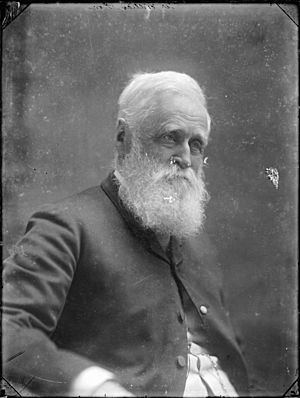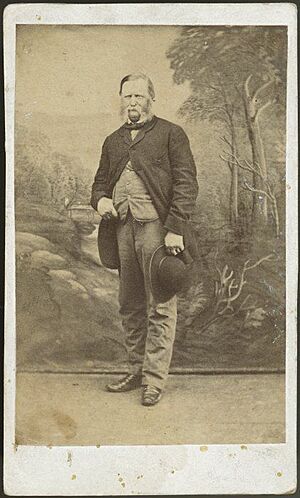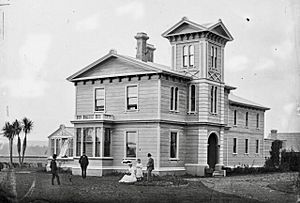William Fox (politician) facts for kids
Quick facts for kids
William Fox
|
|
|---|---|

Fox in 1890
|
|
| 2nd Premier of New Zealand | |
| In office 3 March 1873 – 8 April 1873 |
|
| Monarch | Victoria |
| Governor | Sir George Bowen |
| Preceded by | George Waterhouse |
| Succeeded by | Julius Vogel |
| In office 28 June 1869 – 10 September 1872 |
|
| Monarch | Victoria |
| Governor | Sir George Bowen |
| Preceded by | Edward Stafford |
| Succeeded by | Edward Stafford |
| In office 12 July 1861 – 6 August 1862 |
|
| Monarch | Victoria |
| Governor | Thomas Gore Browne Sir George Grey |
| Preceded by | Edward Stafford |
| Succeeded by | Alfred Domett |
| In office 20 May 1856 – 2 June 1856 |
|
| Monarch | Victoria |
| Governor | Thomas Gore Browne |
| Preceded by | Henry Sewell |
| Succeeded by | Edward Stafford |
| Personal details | |
| Born | 20 January 1812 South Shields, England |
| Died | 23 June 1893 (aged 81) Auckland, New Zealand |
| Political party | None |
| Spouse |
Sarah Halcomb
(m. 1842–1893) |
| Children | Ngataua Omahuru, renamed William Fox (Jr.) (adopted) |
| Alma mater | Wadham College, Oxford |
| Signature | |
Sir William Fox (born January 20, 1812 – died June 23, 1893) was an important leader in New Zealand's early history. He served as the Premier of New Zealand four times when it was still a British colony. He is remembered for his work on education, helping New Zealand become more independent from Britain, and his changing views on Māori land. People described him as smart and determined.
Contents
Early Life and Moving to New Zealand
William Fox was born in England on January 20, 1812. He studied law in London and became a lawyer in 1842. Soon after, he married Sarah Halcomb. They decided to move to New Zealand, a new and growing colony.
They arrived in Wellington. At first, there wasn't much legal work for Fox. He started writing for local newspapers to earn money. In 1843, he had a disagreement and could no longer work as a lawyer. This made him focus even more on writing. He then became an agent for the New Zealand Company in Nelson. This company helped British people move to New Zealand.
Early Political Ideas
When he first arrived, Fox had strong opinions about land in New Zealand. He believed Māori people only had rights to land they actively used. He also criticized the government's response to conflicts over land. His strong words helped lead to the removal of Governor Robert FitzRoy.
In Nelson, Fox worked to help the new settlers. There were problems because the land they were promised was not always what they received. Fox tried to fix these issues. Even though he worked hard, some settlers were still unhappy. Fox enjoyed exploring the wilderness around Nelson. He stayed active throughout his life.
In 1848, Fox took on a bigger role with the New Zealand Company in Wellington. He became a strong opponent of Governor George Grey. Grey had paused a law that would give settlers more self-government. Fox believed the colonial government was not fair or good enough.
In 1851, Fox traveled to London to speak for settlers in Wellington. He shared his ideas for a new government in New Zealand. He wanted settlers to have more control and for parliament to have two elected parts. Britain's parliament passed a new law in 1852 that included some of his ideas.
Becoming a Member of Parliament
| New Zealand Parliament | ||||
| Years | Term | Electorate | Party | |
| 1855–1860 | 2nd | Wanganui | Independent | |
| 1861–1865 | 3rd | Rangitikei | Independent | |
| 1868–1870 | 4th | Rangitikei | Independent | |
| 1871–1875 | 5th | Rangitikei | Independent | |
| 1876–1879 | 6th | Wanganui | Independent | |
| 1880–1881 | 7th | Rangitikei | Independent | |
After his trip, Fox and his wife traveled in North America before returning to New Zealand. In 1855, Fox was elected as a Member of Parliament (MP) for Wanganui. He strongly supported local areas having more power.
In 1856, Fox became New Zealand's second Premier, but only for 13 days! He was quickly replaced by Edward Stafford. Fox spent some time away from politics but later returned to oppose Stafford.
Fox's ideas about Māori land rights seemed to change. He blamed Stafford's government and Governor Thomas Gore Browne for conflicts in Taranaki. These conflicts started when a Māori chief refused to sell his land. Many people thought Fox now supported Māori rights. Some historians believe he just wanted to avoid war.
Becoming Premier
In 1861, Fox became Premier again. He tried to make laws that worked better with Māori ways of life. He also stopped trying to take Māori land and aimed for a more peaceful approach. However, Governor Grey, who was back in New Zealand, wanted to use military force against Māori. This made it hard for Fox's government to build trust.
In 1862, Fox was on a ship called the SS White Swan with other government leaders. The ship hit a rock and started to sink. The captain bravely ran the ship aground, saving everyone on board.
Fox lost his position as Premier in 1862 after disagreements with Governor Grey. He later returned to government as a minister, but not as Premier. During this time, a lot of land was taken from Māori. After this, Fox and his wife traveled in Australia for several years.
When he came back to New Zealand, Fox was encouraged to return to politics. He again became a strong opponent of Edward Stafford. In 1869, Fox defeated Stafford and became Premier for the third time. He focused on reducing military actions. His Treasurer, Julius Vogel, became very important. Vogel had big plans to borrow money for public works like roads and railways. These plans became a main focus of Fox's government.
Fox eventually stepped back from leading the government. This led to disunity, and Stafford defeated him again in 1872. Fox decided he wouldn't seek the top job again. However, he was asked to be Premier one last time in 1873, for a short period, until Julius Vogel returned and took over.
Fox served as a Member of Parliament for different areas, including Wanganui and Rangitikei and Rangitikei, for many years.
William Fox Jr.
In 1868, during a conflict, two Māori scouts found two young boys. One boy, Ngatau Omahuru, was given to a Māori family. Later, a magistrate named Walter Buller took an interest in the boy. He bought him European clothes and had his picture taken.
Ngatau Omahuru was then baptized William Fox, named after William Fox senior, who was an MP at the time. The young William was taken to Wellington and lived there for three years. He went to a private school with other Māori students. Later, he moved in with the Fox family. William Junior and Mrs. Sarah Fox, who did not have her own children, became very close. He lived with them until he was about 12.
In 1874, he started at the new Wellington College. The next year, the Fox family took William Junior on a world tour. They traveled to San Francisco, across the United States, and to Great Britain to visit Fox's relatives.
When he was 16, William Junior started working at a law firm. He trained there for about five years. In 1878, he visited the Taranaki area and met members of his own tribe. He also met important Māori leaders, Te Whiti and Tohu Kākahi, at Parihaka. He decided to live in Taranaki and was greatly influenced by these leaders. He even set up a Māori school near Parihaka.
Later, he worked as a translator and interpreter in Whanganui. He then started a business in Hawera teaching the Māori language. He never married and passed away in 1918.
Later Life and Legacy
In 1879, William Fox was honored and became a Knight Commander of the Order of St Michael and St George (KCMG), which means he was given the title "Sir." He was also asked to investigate Māori land titles.
Fox was very involved in the temperance movement, which worked against alcohol. He helped start the New Zealand Alliance and was its first president from 1887 to 1893.
He stayed very active, even climbing Mount Taranaki in 1892 when he was 80 years old! Sir William Fox died in Auckland on June 23, 1893, at the age of 81. He was buried in Purewa Cemetery.
The town of Foxton, founded in 1885, was named after Sir William Fox.
Westoe House
William Fox bought a large piece of land, about 5,000 acres, near Greatford around 1849. In 1874, a house called Westoe was built for him in the Italianate style. It was sold in 1885 and is now a protected historic place. The gardens at Westoe include a cedar of Lebanon tree that Fox himself planted.



